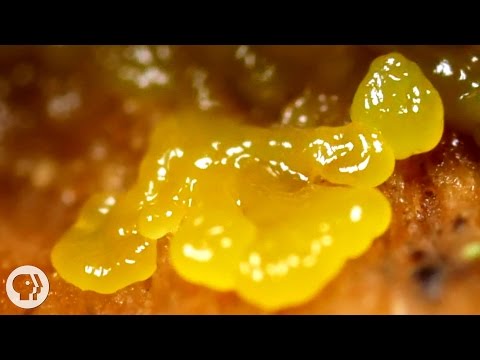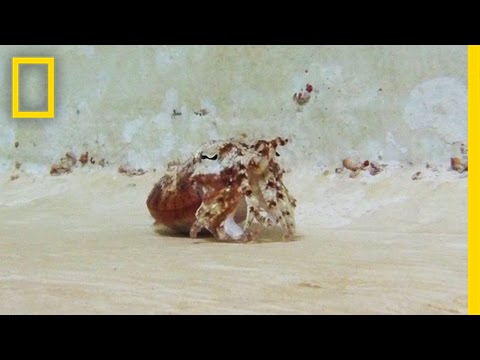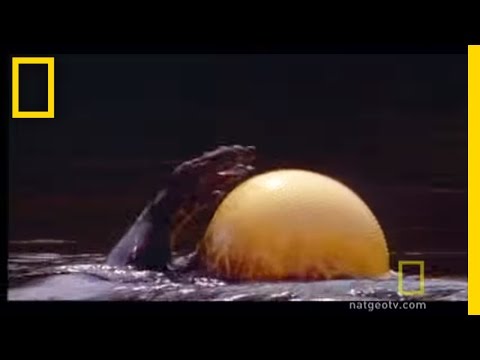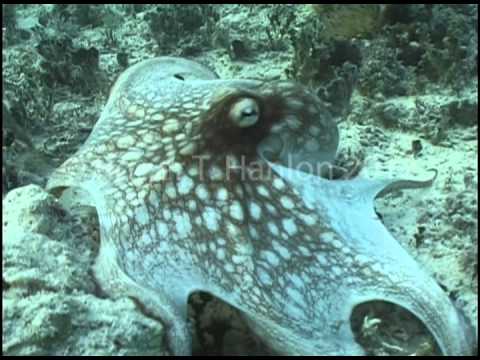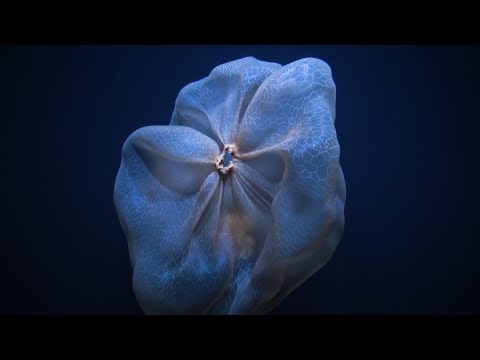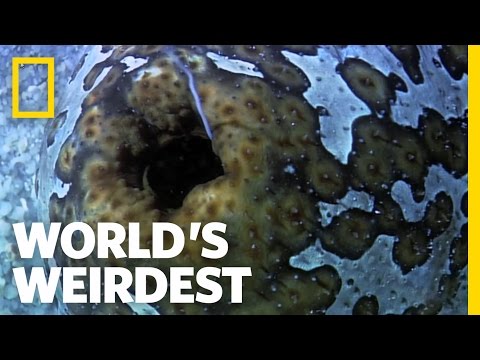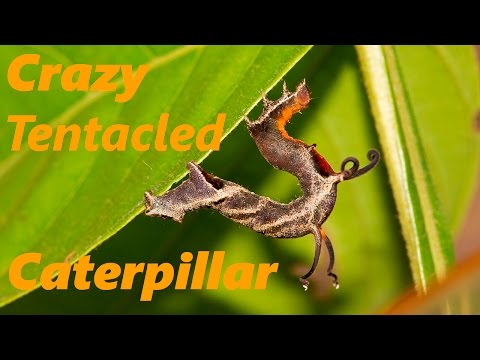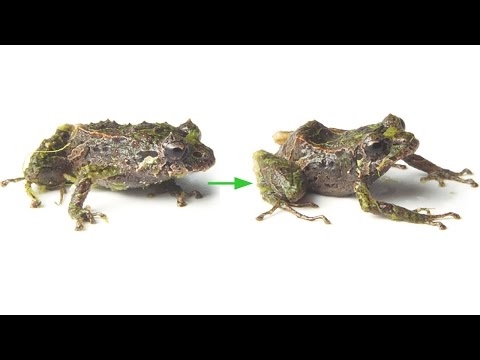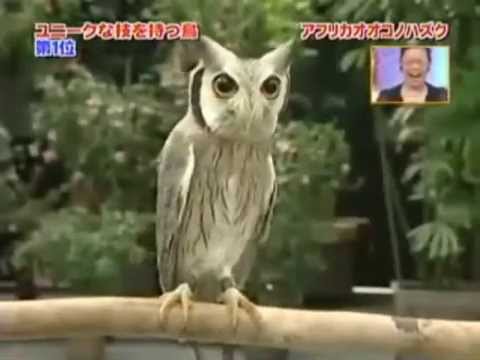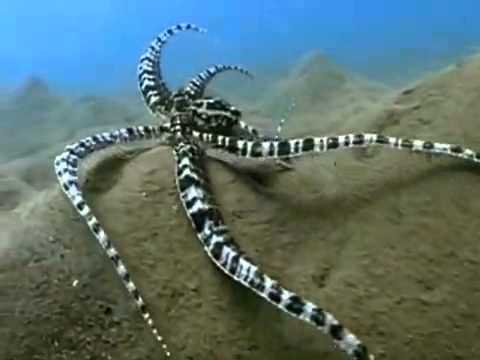Whether they appear to grow in size, contort their body shape, or create the illusion of change, there are organisms all over the Earth that would find our singular body form boring. Here are 10 surprising shape-shifting organisms.
10 Slime Mold
A yellow mass of gel pulsing toward you is the stuff of nightmares. This blob is hungry and searching for food. Bright light scares it and sends it undulating away to find darkness in which to hide. It hunts food by inching across a surface and continually changing shape until it finds something to eat. It’s not a monster. It’s a slime mold. Watch this video on YouTube Slime mold is the name given to many unrelated organisms that live like this. They can exist as single-celled organisms living separately. But when the conditions are right, these individuals can join together to form one enormous cell (called a plasmodium) with many nuclei. It is not the shape change between single-celled individuals and plasmodium that most interests scientists, though. Rather, they are studying closely how the plasmodium changes shape to solve puzzles. Physarum polycephalum, the most studied slime mold, can find the most efficient way through mazes. In one experiment, it was placed on a model of the city of Tokyo. Scientists had placed oats for it to feed on in strategic places. The network that the slime mold formed between sources of food closely matched the rail network of the real city. A slime mold was just as good at city planning as a committee of humans.[1]
9 Cuttlefish
Cuttlefish are amazing creatures. Related to squid and octopuses, cuttlefish share a similar body form but have unique skills. To communicate, cuttlefish will flash complex patterns across their skin using special colored cells that they can contract or expand at will. This ability allows them to blend into their background or even mimic other animals. In the video above, cuttlefish are seen taking on the shape, colors, and mannerisms of hermit crabs. Although exceptionally maneuverable swimmers, they creep along the bottom just as a hermit crab would. As soon as one of the fish they feed on strays too close to this seemingly nonthreatening crab, it shoots out two extending tentacles and grabs the fish. Cuttlefish also use mimicry of hard-shelled crabs to deter predators that would normally eat the soft flesh of the cuttlefish.[2] Other cuttlefish have been seen changing their shapes and colors to become globs of algae, branches of coral, floating seaweed, and other sea creatures.
8 Puffer Fish
The puffer fish (aka blowfish) are among the cutest inhabitants of the ocean. In their relaxed form, they appear somewhat ungainly and seem to peer out at the world with expressions of complete unconcern. They have no need to fear most predators because they have a simple shape-shifting trick that gets them out of most threats. When attacked, the puffer fish swallows many times its own weight in water and blows up into a huge and unwieldy sphere, often covered in sharp spikes. This bamboozles most predators into giving up the attempt to eat the puffer fish. The creature achieves this transformation in shape and size thanks to several adaptations. Its skin is particularly flexible so that it does not tear as it is stretched. The skin contains strong proteins that give it rigidity when taut, making it harder for attackers to puncture.[3] The stomach, into which the water is swallowed, is large but folded in on itself when not being used in defense. As water is taken up, the stomach unfolds. If a predator does manage to catch and eat a puffer fish, then they are in for a nasty surprise. Many puffer fish have internal organs packed with potent toxins.
7 Octopus vulgaris
Octopus vulgaris (aka the common octopus) has some very uncommon abilities. When it comes to camouflage on the seabed, these creatures make it difficult for prey or predators to spot them. These octopuses can hide themselves almost completely in plain sight by pulling in their long tentacles, changing the shape and texture of their bodies, and using their ability to change color. The ancestors of octopuses had shells to protect them. Without this refuge on their backs, they needed to develop other defenses. Should a predator discover the octopus despite its disguise, the octopus can change its shape in other ways to escape. It may billow out its tentacles to appear larger or thrust them at the predator to scare it off. If those tactics fail, then the octopus, thanks to its flexible shape, can escape through the tiniest of gaps in the rocks.[4]
6 Deepstaria enigmatica
Imagine that you are swimming in the abysmal blackness of the ocean at a depth of 1,525 meters (5,000 ft). No sunlight can reach there, and you only have a tiny torch lighting your immediate vicinity. Out of the darkness blooms a shifting curtain of flesh that threatens to envelope you. Watch this video on YouTube Luckily, humans cannot swim at that depth. But those who control submarines have faced this situation. Deepstaria enigmatica is a type of jellyfish that does not have the tightly contained bell shape of many jellyfish. The walls of its bell are very thin and slowly ripple as it moves.[5] At one moment, it might be tightly contained within itself. The next, the creature is using its huge surface area to drift toward you. The shape of the jellyfish is controlled by a mesh of muscles embedded in the walls. The jellyfish captures its prey when they blunder inside the parachute of its body. Once inside, the walls contract and expose the unfortunate captive to stinging cells that paralyze it, allowing the jellyfish to begin digesting its victim.
5 Sea Cucumbers
Like many invertebrates without exoskeletons, sea cucumbers move by suitably changing their shape. That is not so impressive. As the video above shows, the humble sea cucumber has a few other shape-shifting abilities that set it apart. Some sea cucumbers can spread a large array of slender tentacles to grab passing particles of food or even larger creatures. Perhaps the most shocking way that a sea cucumber can change shape is found at the opposite end from its mouth. When threatened, they can expel their guts from their anus. The filaments of the guts are toxic and can kill the attacker. The secret to the sea cucumber’s ability to change shape has only recently been uncovered. These creatures can rapidly move from a rock-hard structure to a jellylike flexibility.[6] Their tissues are full of stiff protein collagen. Unlike in most organisms, however, it is under the control of the nervous system. Whether the tissue is hard or soft is decided by the simple neural network of the sea cucumber.
4 Tentacled Caterpillar
When entomologist Aaron Pomerantz was examining the top of the tree canopy in the Peruvian jungles, he noticed something strange. While shouting down to his colleagues, he saw something moving on a leaf nearby. Watch this video on YouTube The jungles of the world teem with creepy-crawlies, so that is not so unusual. What was strange was that this particular bug was clearly reacting to the noise of his voice. Every time that he yelled, the small caterpillar would shoot out four tentacles. By pumping liquid into the appendages on their backs, these creatures can double their length.[7] Also called horned-spanworms or filament bearers, these caterpillars have strange shape-shifting abilities that are not yet explained by science. According to one theory, the change in shape mimics the motion of a falling brown flower. Others think that these caterpillars put out the tentacles so that a predator is more likely to grab the tentacle instead of the caterpillar itself. It could also be that the tentacles can sense vibrations and warn the caterpillar of attack.
3 Mutable Rainfrog
Although we’ve seen invertebrates change the texture of their skin, the first vertebrate to do so was discovered in Ecuador in 2006. The mutable rainfrog can rapidly go from a smooth-skinned frog to one with spines. The discoverers noticed the unusual ability immediately and knew that they were looking at something new. By studying the frogs in the wild, they saw how the creature was able to respond to threats by becoming spiky. As the perceived threat recedes, the frog can alter its skin to smoothness to allow it to move and swim normally. When the animal was studied, it was found to be a new species. Looking at closely related frogs, the researchers discovered that several other species were also able to change the texture of their skin, although no one had noticed it before. Due to its spiky appearance, the mutable rainfrog has been unofficially dubbed the “punk rocker frog” by the team that discovered it.[8]
2 Northern White-Faced Owl
Puffing yourself up to deter predators is a common tactic in the animal kingdom. Even humans will use it in confrontations. The northern white-faced owl can go both ways. Depending on the threat, the owl will either make itself larger or smaller. If the predator is close to its own size, the owl spreads its wings and flattens the feathers around its face to make it appear much larger than its relatively small body size. If the threat is too large to deceive that way, the owl will pull its wings over its chest, tuck in its feathers, and elongate its body in an attempt to shrink into the background. In the wild, if it is caught on a tree limb when a larger predator appears, a northern white-faced owl may pull this trick and lean to the side to resemble a smaller branch on the tree.[9]
1 Mimic Octopus
Although they’re not rare, the mimic octopus was only discovered in 1998. That should give some clue as to the extraordinary powers of this cephalopod. With its abilities to change color, shape, and behavior, the mimic octopus has a range of disguises to suit any eventuality. The octopus is relatively vulnerable to attack. To survive, it imitates animals that other creatures would not like to tangle with. To sneak along the seabed, it mimics a poisonous flounder and ripples against the sand. When it needs to swim above the seabed, the mimic octopus will extend its tentacles to copy the shape of the poisonous barbs of the lionfish. If cornered, this octopus will display the colors of a venomous sea snake and use its tentacles as if ready to attack. Other disguises in its repertoire include stingrays, mantis shrimp, anemones, and jellyfish. The mimic octopus is the king of the shape-shifting world.[10]
